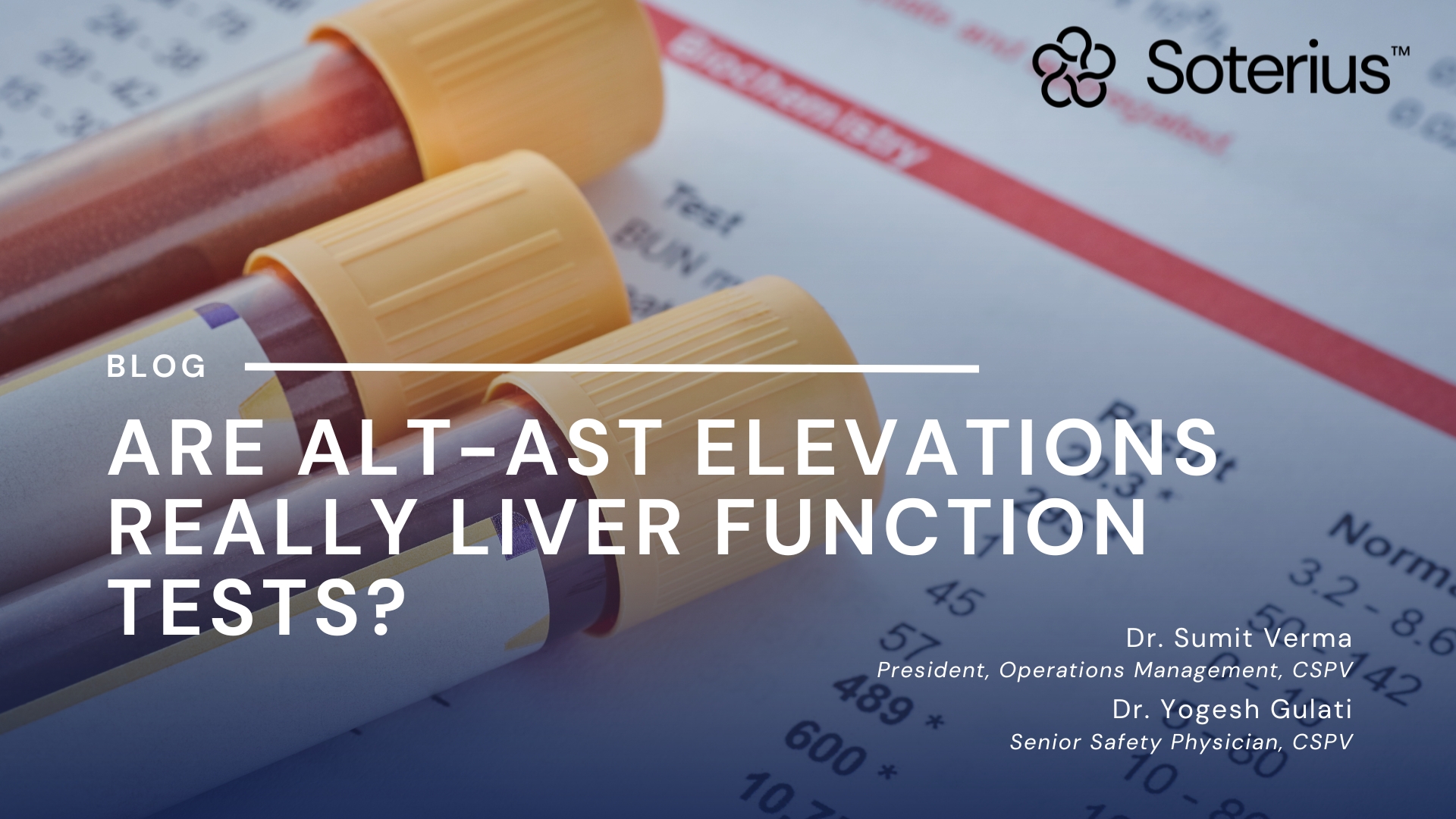
Are ALT & AST Elevations Really Liver Function Tests
Liver biochemical tests are very commonly performed in clinical studies/clinical practice. These tests include:
- Alanine/aspartate aminotransferases (ALT/AST), Alkaline phosphatase (ALP), Gamma-glutamyl transferase (GGT)
- Bilirubin, Albumin
- Prothrombin time (PT), International normalized ratio (INR)
These tests are commonly used for the diagnosis and evaluation of acute and chronic liver disease, irrespective of the ethology.
-
Liver Injury Vs. Liver Function
There are two separate concepts for drug-induced liver injury: severity of liver injury and the grade of liver function impairment
-
Liver Injury Indicators:
- Tests: ALT (Alanine Aminotransferase) and AST (Aspartate Aminotransferase): Elevated levels of ALT and AST indicate liver cell damage, suggesting liver injury.
-
Liver Function Impairment Indicators:
- Tests: Albumin, PT (Prothrombin Time), INR (International Normalized Ratio), and Bilirubin: Decreased albumin or increased PT, INR, or bilirubin levels indicate impaired liver function.
Therefore, the term Liver function tests (LFTs) being used for elevations of ALT and AST is somewhat of a misnomer because these enzymes do not represent liver function but rather indicate the damage of liver cells. On the other hand,
albumin, bilirubin, and vitamin K-dependent clotting factors represent synthetic function of the liver. The decreased synthesis of clotting factors by the liver may lead to prothrombin time (PT) prolongation and an increase in the
international normalized ratio (INR).
Some of the commonly used scores to predict mortality in patients with cirrhosis such as the Child-Pugh score and Model for End Stage Liver Disease (MELD) score do not use AST, ALT, or ALP but instead use INR, bilirubin and albumin in
Child-Pugh score and INR and bilirubin in MELD score.
The following table reflects a summary of the commonly used serum liver tests in clinical studies/clinical practice:
Liver Injury Tests
| Category | Test | Conditions Associated with Abnormal Liver Injury Tests | Site of Localization |
| Hepatocellular Injury | ALT | Hepatocellular injury, muscle injury, rhabdomyolysis | Liver, cardiac muscle, skeletal muscle |
| AST | Hepatocellular injury, muscle injury, rhabdomyolysis, haemolysis | Liver, cardiac muscle, skeletal muscle, brain, kidney, RBC | |
| Cholestasis | ALP | Cholestasis, biliary injury, bone disorders, late pregnancy | Liver, kidney, bone, intestine, placenta |
| GGT | Cholestasis, biliary injury, alcohol intake, obesity, smoking | Liver, pancreas, kidney, intestine, spleen, prostate | |
| Total Bilirubin (Direct + Indirect) | Direct > Indirect: Hepatocellular injury, cholestasis; Indirect > Direct: Haemolysis, Gilbert’s syndrome | Circulates in blood in unconjugated (indirect) form and undergoes conjugation (direct) in the liver |
Liver Function Tests
| Test | Site & Function | Conditions Associated with Abnormal Liver Function Tests |
| Albumin | Main protein produced by the liver, circulates in serum, and maintains serum oncotic pressure. | Acute Liver Disease: Albumin synthesis usually preserved. Chronic Liver Disease: Low serum albumin indicates cirrhosis. |
| PT/INR | Indicates the function of vitamin K-dependent clotting factors mainly synthesized in the liver. Test measures the extrinsic coagulation pathway. | Aids in the diagnosis of both acute and chronic hepatic disorders. |
The below table indicates a pattern of alterations of liver injury tests and liver function tests in hepatocellular injury & cholestasis:
| TEST | HEPATOCELLULAR INJURY | CHOLESTASIS |
| Liver Injury Tests | ||
| ALT/AST | ++/+++ | 0/+ |
| ALP | 0/+ | ++/+++ |
| Total Bilirubin | 0/+++ | 0/+++ |
| Liver Function Tests | ||
| PT/INR | Prolonged | Prolonged |
| Albumin | -/—- | 0 |
Stopping Rules for the Drugs in Premarketing Clinical Studies for Hepatotoxicity:
In clinical trials, it is often difficult to determine when the study drug should be stopped. This is because transient increase of ALT or AST are quite common and progression to severe DILI or acute liver failure is usually uncommon, stopping the study drug on an increase in ALT or AST greater than 3xULN may be unnecessary. For most individuals, the liver appears capable of adapting to injury by chemical substances, which may render a person tolerant to the drug despite continued exposure. Stopping a drug at the first indication of mild injury does not allow knowledge if adaptation will occur, as it does for drugs such as tacrine, which cause liver injury but do not cause severe DILI. On the other hand, if there is marked increase in serum aminotransferases or there is evidence of functional liver impairment (as indicated by rising INR or bilirubin) which represent substantial liver injury, continuing with the study drug appears unacceptably dangerous.
Hence, the USFDA guidance mentions that in the premarketing clinical studies, discontinuation of the study drug should be considered if any of the following occurs:
- ALT or AST >8 x Upper Limit of Normal (ULN)
- ALT or AST >5 x ULN for more than 2 weeks
- ALT or AST >3 x ULN and (Total bilirubin >2 x ULN or INR >1.5)
- ALT or AST >3 x ULN with the appearance of fatigue, nausea, vomiting, right upper quadrant pain or tenderness, fever, rash, and/or eosinophilia (>5%)
It is important to note that these stopping rules are guidelines and may further evolve based on advances in medical research and knowledge. The safety of study participants should always be the top priority, and the final decision to stop a study due to hepatotoxicity will be made by the study sponsor in consultation with multiple key stakeholders including regulatory agencies, investigators, and independent safety monitoring committees.
References
- Drug-induced liver injury (DILI): Current status and future directions for drug development and the post-market setting. A consensus by a CIOMS Working Group. Geneva, Switzerland: Council for International Organizations of Medical Sciences (CIOMS), 2020.
- Ricart A.D. Drug-induced liver injury in Oncology. Annals of Oncology. Volume 28; Issue 8; P2013-2020,August 2017.
About Soterius
Soterius is a strong team of pharma professionals who design customized, innovative, and cost-efficient processes for clinical safety, pharmacovigilance, and medical affairs. Our deep industry knowledge and up to date insights let us combine agile, people powered intelligence in pioneering customer centric solutions. Our innovative technology solutions include engagement tools and communications platforms to create a unified and compliant medical access facility. With a strong global presence, we provide comprehensive clinical and post marketed safety services, that include aggregate report writing, signal detection and management, global literature surveillance, risk management, case processing and regulatory reporting. We use state-of-the-art technologies to solve complex safety operations problems, be it case processing, intake, site reporting for clinical trials, or literature search and management. We have one of the most accurate solutions for case intake and case processing using AI.
We support companies from the initial development stage of a drug/vaccine to the approval and ultimate marketing of the therapy, supporting ongoing operations and regulatory commitments globally.

